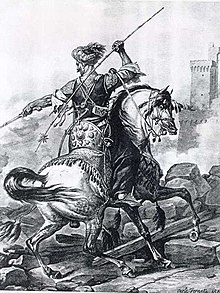British period
The British East India Company made its first contacts in the Sindhi port city of Thatta, which according to a report was: "a city as large as London containing 50,000 houses which were made of stone and mortar with large verandahs some three or four stories high the...the city has 3000 looms...the textiles of Sind were the flower of the whole produce of the East, the international commerce of Sind gave it a place among that of Nations, Thatta has 400 schools and 4,000 Dhows at its docks, the city is guarded by well armed Sepoys..."British and Bengal Presidency forces under General Charles James Napier arrived in Sindh in the nineteenth century and conquered Sindh in 1843. The Sindhi coalition led by Talpurs and Kalhoras under Mir Nasir Khan Talpur were defeated in the Battle of Miani, during which 50,000 Sindhis were killed. Shortly afterward, Hoshu Sheedi commanded another army at the Battle of Dubbo, where 5,000 Sindhis were killed. The first Agha Khan helped the British in their conquest of Sindh, and as result he was granted a lifetime pension.
A British Journal[18] by Thomas Postans, mentions the captive Sindhi Amirs: "The Amirs as being the prisoners of "Her Majesty"... they are maintained in strict seclusion; they are described as Broken-Hearted and Miserable men, maintaining much of the dignity of fallen greatness, and without any querulous or angry complaining at this unlivable source of sorrow, refusing to be comforted"
Emir Hosh Muhammad Sheedi (Hoshu Sheedi) at Dubbo

No comments:
Post a Comment